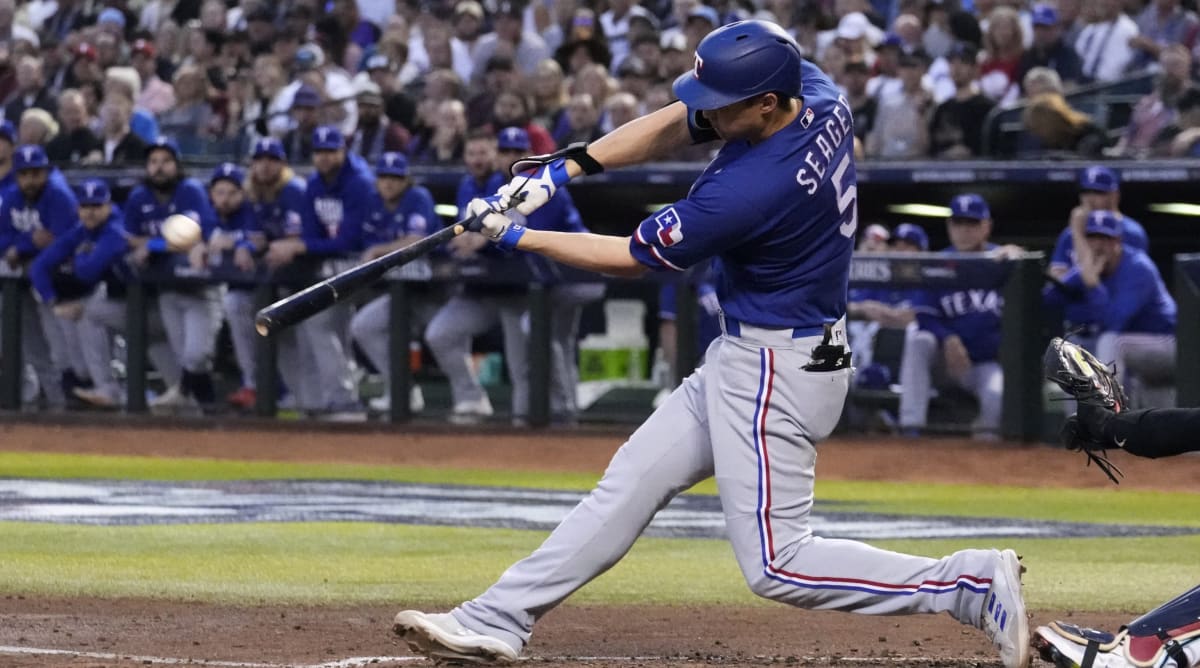On Monday night, Corey Seager looked like himself again. Which is to say that the Rangers shortstop hit a home run and reacted with near indifference, calmly setting down his bat, not so much as a smile on his face. He jogged around the bases with an air of obligation that would be more befitting someone walking up to an appointment at the DMV than hitting a moonshot in the World Series.
Seager’s two-run shot in the third inning helped push the Rangers to a 3–1 victory over the Diamondbacks. It puts Texas up in the series two games to one. And it marks a return to form for Seager. He has been hitting home runs like this all October. But after the rare displays of emotion accompanying his game-tying shot in Game 1 of the World Series and his first-inning blast in Game 7 of the ALCS? His businesslike calm on Monday was more like what we’re used to seeing.
He knew, the bench knew, we all knew. pic.twitter.com/JqV06oVkgy
— Texas Rangers (@Rangers) October 31, 2023
Asked by reporters what he saw from the 87-mph changeup and how it felt to drive it out of the park, Seager gave only a few words.
“Just a good pitch,” he said. “Fortunately, I got it, and fortunately, I put a good swing on it.”
Rangers offensive coordinator Donnie Ecker has settled on a metaphor for Seager. His famously reserved infielder is not a robot, or a cyborg, or any of the various other mechanical terms often used to describe him. No, he’s something far more human, if not easier to understand, Ecker says. The shortstop is a starting pitcher.
“There’s a process,” Ecker says. “When the game starts, he has his own process, and it’s very businesslike.”
Much like a starting pitcher, Seager is obsessive about his routine, channeling all his intensity into a carefully orchestrated preparatory system. “He will not put his energy toward anything, even a conversation, if it does not go toward winning,” Ecker says of Seager leading up to and during a game. Every outing is treated as a maximum-effort, high-performance, leave-it-all-out-there showcase. A starting pitcher, of course, does that about once a week. Seager does it every day.

Joe Rondone/USA TODAY Network
The result is a player who can be difficult to understand from a distance. Seager shirks the spotlight and rarely shows emotion on the field. This was true in his seven seasons with the Dodgers—during which he won Rookie of the Year in 2016 and World Series MVP in ’20—and it has continued in his tenure with the Rangers. When he signed his 10-year, $325-million contract with Texas in 2021, he became the face of a franchise and a symbol of its hopes. But he shared very little publicly about what that path meant to him or why he chose it. Even a few minutes of a postgame broadcast interview is rare exposure for the 29-year-old Seager. Instead, he goes about his business as quietly as is possible for a multiple-time All-Star, devoted to his routine day after day, and the robot metaphors have proliferated as a result.
But his first postseason with the Rangers has put a spotlight on something his teammates have known from the start in Texas. It is not that Seager does not care. It is certainly not that he is unfeeling or robotic. It is rather that he cares so much as to be inwardly consumed by it. And as Seager has starred on the biggest stage in October, standing out as one of the most dangerous, patient hitters in the game, he has occasionally let some of that care become more visible.
“He finally showed emotion on the baseball field,” Rangers first baseman Nathaniel Lowe marveled earlier in the World Series.
Lowe was quick to clarify that the only remarkable part of that sentence is the final prepositional phrase. He’s seen Seager get fired up plenty of times—playing cards, shooting hoops, even a few days on the golf course. “He’s a human being,” and a great teammate besides, Lowe said. But he’d never seen any of that emotional spirit on the ballfield. He pushes back on the idea that Seager is robotic, but given what fans see of him on the field, Lowe understands why the misconception exists. When it comes to hitting, Seager is ever stoic, intensely focused but always even-keeled. After the visible passion he showed on his last few home runs? Monday’s total composure was far more characteristic.
“That biggest takeaway for me is just how calm and how present he is at all times,” Rangers left fielder Evan Carter said of Seager. “No matter, if we're getting beat really bad, we're up a lot, just how calm and how he is where his feet are.”

Rob Schumacher/USA TODAY Network
He is usually one of the first players to arrive at the ballpark. For an ordinary night game in the regular season, Seager tends to show up before noon, and he may come even earlier during big series. He uses the next five hours to run through a “meticulous process,” Ecker says. Seager begins with an involved, highly choreographed series of stretches. He then moves to the batting cage. But he does not swing freely. Instead, Seager takes just a handful of swings each day—almost never more than two or three dozen in total. He films each one from multiple angles. (“He’s probably bought the largest data storage,” Ecker says. “I’ll put it that way.”) He then privately reviews every angle of every swing, freezing and zooming in on the film, trying to pinpoint the nuances of every mechanical detail.
He works closely with Ecker. But he also has a private swing consultant. Seager uses former MLB catcher Shawn Wooten, who originally became close with the shortstop with the Dodgers, for whom he served as a minor-league hitting coach from 2014-16 and a big-league coach in ‘17. Wooten now runs a private hitting facility in Minnesota. But he is in contact with Seager almost every day. After he’s examined his initial set of swings, Seager reviews the information on a call with Wooten, and he then brings the findings back for one more round in the cage with Ecker. And then comes regular prep with the rest of the team.
“I just like having a plan,” Seager says. “I want to know where I’m at before I step in there [during a game]. I don’t want to have to figure things out on the fly.”
In other words, Seager does not take any part of his swing for granted. Instead, he builds it from the ground up each day. He cares too much—too intensely—to leave anything to chance. Some hitters work by feel. Seager is the opposite.
His approach has paid off. The Rangers now sit two wins away from the first World Series title in their history. And if they get there? Texas might finally get a little bit more emotion from Seager.







